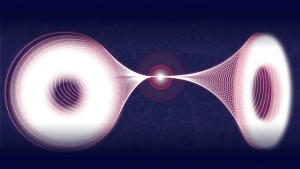Oct 25 2013
Light can be confined inside a reflective medium—a stream of water, a thread of glass fiber. In fiber optics, the light moves, trapped in a glass strand via the mechanism of total internal reflection. Light “totally” bounces at the surfaces, back and forth, carrying information over vast distances.
Perhaps the word total should be taken a little loosely, at least at the surface. Here, there is what’s called an evanescent field. Webster says “evanescent” means “tending to dissipate, like vapor.” In physics, an evanescent wave is a vanishing vibration, occurring at an interface. They occur because nature doesn’t like discontinuity. The evanescent field isn’t the same as leaky, inefficient fibers; it is always present as light moves through the fiber.
 Graphic interpretation of higher mode traveling in a tapered optical fiber. (credit E. Edwards/JQI)
Graphic interpretation of higher mode traveling in a tapered optical fiber. (credit E. Edwards/JQI)
“Dissipating, like vapor” doesn’t sound like something useful, but in fact, under certain conditions, evanescent waves can be used to isolate and probe atoms. Atoms trapped in the evanescent wave can interact with light traveling in the fiber. The information from that interaction is not lost; the light then re-enters, or “couples,” back into the fiber and can be captured on a camera.
The fibers in communications are relatively large compared to the wavelength of light, about 10 to 100 times greater depending on the length and use of the fiber. Harnessing evanescent fields requires reducing the fiber core. Here the team heats up a fiber while simultaneously stretching it—a technique reminiscent of glass blowing—down to a diameter of 350 nm. This is more than two times smaller than the light’s wavelength (780 nm), which means that somewhere along the line, the light can’t completely fit inside the fiber. Instead, its electric field is mostly outside the core—where it can interact with atoms, for instance. [see accompanying video of fiber pulling and injected light, monitored on a camera]
The cross-section of a light beam, such as those from lasers, often looks smooth, with the brightest part in the middle and decreasing intensity away from the center. But this is only one example of what is called a spatial light “mode.” Higher modes, those that have more spatial components can also be made. These modes visually can look like a doughnut, cloverleaf, or another more complicated pattern.
Stretching an optical nanofiber
Higher modes offer some advantages over the lowest order or “fundamental” mode. Due to their complexity, the evanescent field can have comparatively more light intensity in the region of interest –-locally just outside the fiber. These higher order modes can also be used to make different types of optical patterns. Generally speaking, to have complete control over an atomic gas, the researchers require maximal flexibility in the power and shape of the trapping light.
In this experiment, the team squeezes combinations of higher modes of the light into a nanofiber with unprecedented efficiency and purity. Ninety-seven percent passes through the tapered nanofiber—this is compared to previous work of around 20 percent. In contrast to a high purity fundamental mode, their design allows for 99 percent of the light to be in higher mode configurations. This kind of control would potentially translate into more control over evanescent atom traps.
This paper describes some of the first results from the hybrid project at JQI called “Atoms on SQUIDS.” This project seeks to couple cold gases to superconducting systems. Hybrid approaches are collectively seen as a necessity in developing quantum information resources. This particular project is extremely challenging because it requires coupling two platforms that use seemingly disparate technologies.
Check out this video to see the propagation of light in the team’s nanofiber. The experimental results described here took place outside of a vacuum chamber. The team also has a nanofiber under vacuum and has successfully trapped rubidium atoms from a laser-cooled gas.
This article was written by E. Edwards/JQI. Video produced by S. Kelley/E. Edwards/J. Robinson in collaboration with authors. The data/media from paper was re-used with permission of authors.